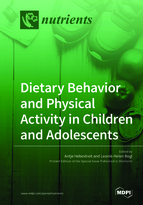Dietary Behavior and Physical Activity in Children and Adolescents
A special issue of Nutrients (ISSN 2072-6643).
Deadline for manuscript submissions: closed (15 April 2019) | Viewed by 116581
Special Issue Editors
Interests: nutrition assessment; child and adolescent nutrition; energy intake; physical activity and sedentary behavior; obesity; non-communicable diseases
Special Issues, Collections and Topics in MDPI journals
2. Department of Epidemiology, Center for Public Health, Medical University of Vienna, Kinderspitalgasse 15, 1090, Vienna, Austria
Interests: lifestyle behaviors; pediatric obesity; metabolic health; family studies; family resemblance
Special Issue Information
Dear Colleagues,
Dietary behavior, sedentary behavior and physical activity are important modifiable lifestyle behaviors that may help children and adolescents to maintain a healthy body weight and prevent health problems. Families have an important role in children's development as they shape children’s early experiences with food and provide the first opportunities for children to be physically active. As children grow older, school influences and peer relationships gain increasing importance. Emerging evidence suggests that lifestyle factors may interact with early-life and genetic risk factors that predispose certain children to obesity and related health outcomes.
This Special Issue of Nutrients, entitled “Dietary Behavior and Physical Activity in Children and Adolescents" welcomes the submission of original research on observational and intervention studies, systematic reviews, meta-analyses and studies on monitoring and surveillance in young populations. Topics of interest include, but are not limited to the following:
- Determinants of dietary behavior and physical activity in young populations, especially their changing role during the transition from childhood to adolescence
- Associations between dietary behavior and physical activity and
- nutritional status
- metabolic health
- wellbeing/mental health
- musculoskeletal health
- biological markers
- Methodological studies, such as validation studies, biomarker studies, pilot studies and studies on diet quality indices in children and adolescents
- Novel and innovative topics including genetic determinants, gene-behavior interactions, prenatal and early life factors, gut microbiota and metabolomics
Dr. Antje Hebestreit
Dr. Leonie-Helen Bogl
Guest Editors
Manuscript Submission Information
Manuscripts should be submitted online at www.mdpi.com by registering and logging in to this website. Once you are registered, click here to go to the submission form. Manuscripts can be submitted until the deadline. All submissions that pass pre-check are peer-reviewed. Accepted papers will be published continuously in the journal (as soon as accepted) and will be listed together on the special issue website. Research articles, review articles as well as short communications are invited. For planned papers, a title and short abstract (about 100 words) can be sent to the Editorial Office for announcement on this website.
Submitted manuscripts should not have been published previously, nor be under consideration for publication elsewhere (except conference proceedings papers). All manuscripts are thoroughly refereed through a single-blind peer-review process. A guide for authors and other relevant information for submission of manuscripts is available on the Instructions for Authors page. Nutrients is an international peer-reviewed open access semimonthly journal published by MDPI.
Please visit the Instructions for Authors page before submitting a manuscript. The Article Processing Charge (APC) for publication in this open access journal is 2900 CHF (Swiss Francs). Submitted papers should be well formatted and use good English. Authors may use MDPI's English editing service prior to publication or during author revisions.
Keywords
- Dietary behavior
- Physical activity
- Determinants
- Childhood obesity
- Child health
- Adolescent obesity
- Adolescent health
- Methodological studies
- Biological markers








